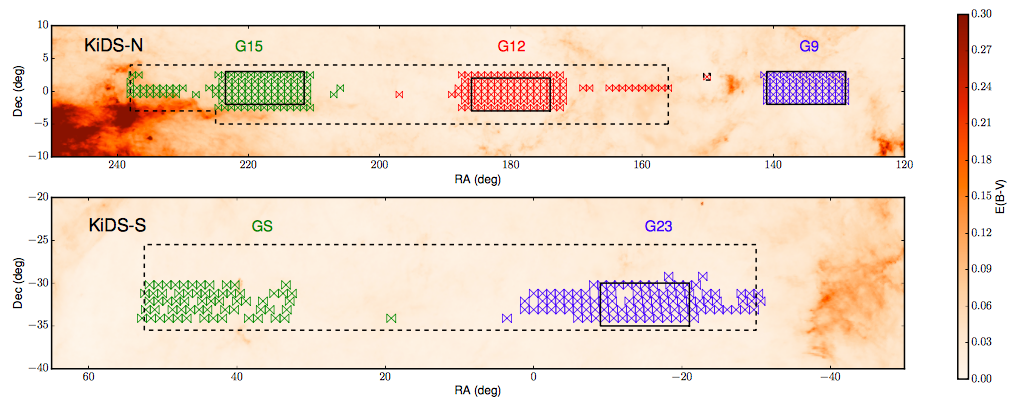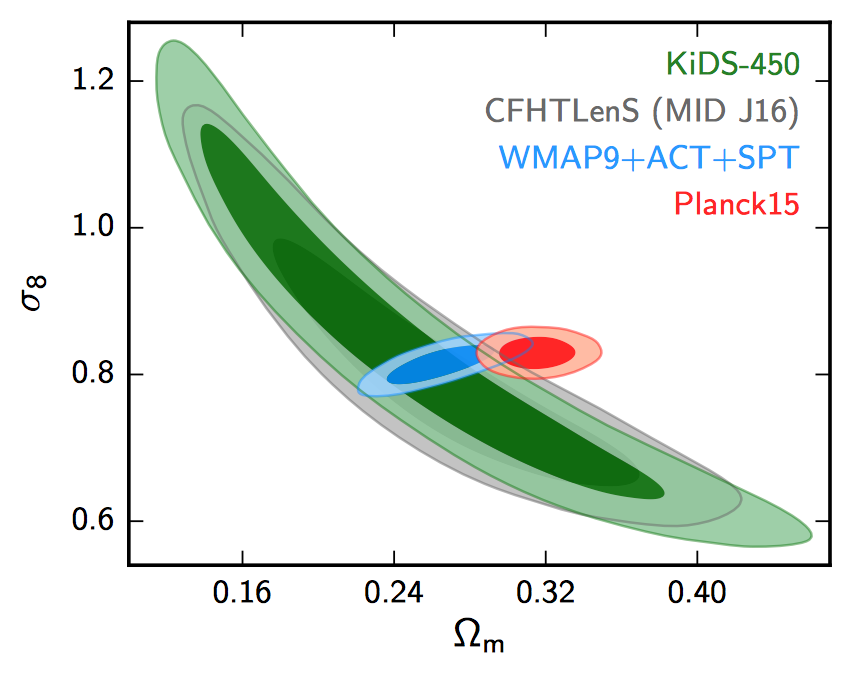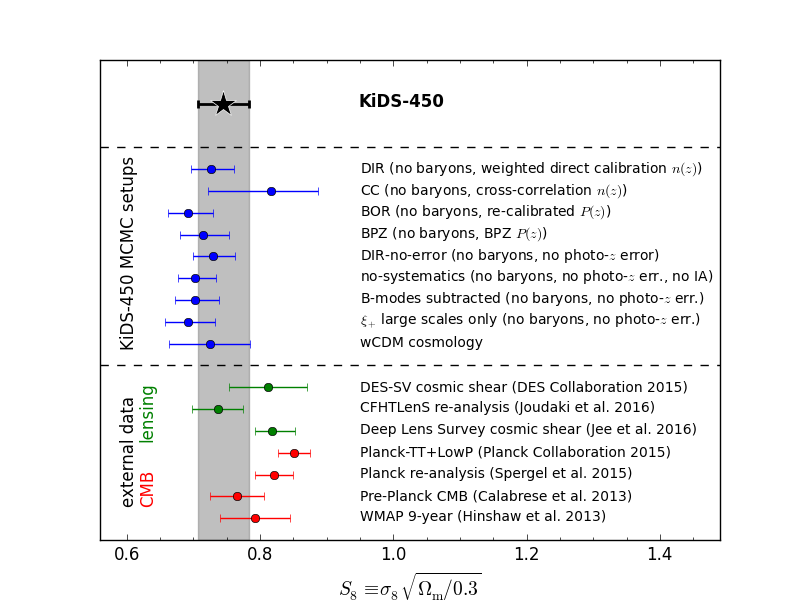KiDS-450: Cosmological parameter constraints from tomographic weak gravitational lensing
Welcome to the webpage dedicated to the release of data products that were used in the KiDS-450 cosmic shear analysis published in Hildebrandt & Viola et al. (2017). This analysis is based on 450 sq. deg. of 4-band (ugri) KiDS data. The footprint of the survey is shown in Fig.1.
Fig. 1: KiDS full survey footprint (dashed line) with the KiDS-450 tiles (colored symbols) and GAMA regions (solid lines) overplotted.
Paper
KiDS-450: Cosmological parameter constraints from tomographic weak gravitational lensing
H. Hildebrandt, M. Viola, C. Heymans, S. Joudaki, K. Kuijken, C. Blake, T. Erben, B. Joachimi, D. Klaes, L. Miller, C.B. Morrison, R. Nakajima, G. Verdoes Kleijn, A. Amon, A. Choi, G. Covone, J.T.A. de Jong, I. Fenech Conti, J. Harnois-Déraps, R. Herbonnet, H. Hoekstra, J. McFarland, A. Mead, J. Merten, N. Napolitano, J.A. Peacock, M. Radovich, P. Schneider, P. Simon, E.A. Valentijn, J.L. van den Busch, E. van Uitert, L. Van Waerbeke
We present cosmological parameter constraints from a tomographic weak gravitational lensing analysis of 450 deg2 of imaging data from the Kilo Degree Survey (KiDS). For a
flat ΛCDM cosmology with a prior on H0 that encompasses the most recent direct measurements, we find S8≡σ8√(Ωm/0.3) = 0.745±0.039 This result is in good agreement with other low redshift probes of large scale structure, along with pre-Planck cosmic microwave background constraints. A 2.3σ-tension in S8 and 'substantial discordance' in the full parameter space is found with respect to the Planck 2015 results. This is similar to the tension reported with measurements from the Canada-France-Hawaii Telescope Lensing Survey despite the introduction of a number of significant advances for the KiDS weak lensing analysis.
We use shear measurements for nearly 15 million galaxies, determined with a new improved 'self-calibrating' version of lensfit validated using an extensive suite of image simulations. Photometric redshifts are estimated from 4-band ugri data and are calibrated directly with deep spectroscopic surveys. The redshift calibration is confirmed using two independent techniques based on angular cross-correlations and the properties of the photometric redshift probability distributions. Our covariance matrix is determined using an analytical approach, verified numerically with large mock galaxy catalogues. We account for uncertainties in the modelling of intrinsic galaxy alignments and the impact of baryon feedback on the shape of the non-linear matter power spectrum, in addition to the small residual uncertainties in the shear and redshift calibration. Our high-level data products, including shear correlation functions, covariance matrices, redshift distributions, and Monte Carlo Markov Chains are available on this page.
Full paper: Hildebrandt & Viola et al. 2017, MNRAS, 465, 1454 (PDF) (ADS)
Main results
Figure 2 shows the constraints in the Ωm vs. σ8 plane from KiDS-450 cosmic shear tomography (green) in comparison to CFHTLenS (gray), WMAP9+ACT+SPT (blue), and Planck 2015 (orange).
Fig. 2:
The parameter that is best constrained by cosmic shear is a combination of Ωm and σ8 called S8=σ8*√(Ωm/0.3). The KiDS-450 constraints for different setups and external constraints are shown in Fig.3
Fig. 3:
Data products
Primary Monte Carlo Markov Chain
The primary analysis (corresponding to the green contours in Fig.2 and the black star in Fig.3) uses the most sophisticated treatment of systematic errors and the best redshift distributions. The Monte Carlo Markov Chain that was for example used to create the green contours in Fig.2 is available here together with a README file describing its creation and further use:
- Monte Carlo Markov Chain: tar.gz (91 MB) or FITS (60 MB)
- MCMC_README.html
KiDS-450 Cosmic Shear data products
The information about this cosmic shear data release can be found in a README or you can download a tarball that contains:
- The Data Vector (tomographic two-point correlation function)
- The Covariance Matrix
- The DIR redshift distribution (with 1000 realisations for error analyses)
- The CC redshift distribution (uncorrelated errors only; if you would like to access the bootstrap realisations please contact us)
KiDS-450 Shear catalogues
The KiDS-450 shear catalogues are publicly available. Please visit the following webpage for further details.
→ KiDS-450 Weak Lensing Catalog
Contacts
For questions please contact Hendrik Hildebrandt (hendrik@astro.uni-bonn.de) and Massimo Viola (viola@strw.leidenuniv.nl).
Acknowledgements
Users of these data should include the following acknowledgment to the source of the data:
Based on data products from observations made with ESO Telescopes at the La Silla Paranal Observatory under programme IDs 177.A-3016, 177.A-3017 and 177.A-3018.
and should cite Hildebrandt & Viola et al. (2017), Fenech Conti et al. (2016) and accompanying papers as follows:
We use cosmic shear measurements from the Kilo-Degree Survey (Kuijken et al. 2015, Hildebrandt & Viola et al. 2017, Fenech Conti et al. 2016), hereafter referred to as KiDS. The KiDS data are processed by THELI (Erben et al. 2013) and Astro-WISE (Begeman et al. 2013, de Jong et al 2015). Shears are measured using lensfit (Miller et al. 2013), and photometric redshifts are obtained from PSF-matched photometry and calibrated using external overlapping spectroscopic surveys (see Hildebrandt et al. 2016).




